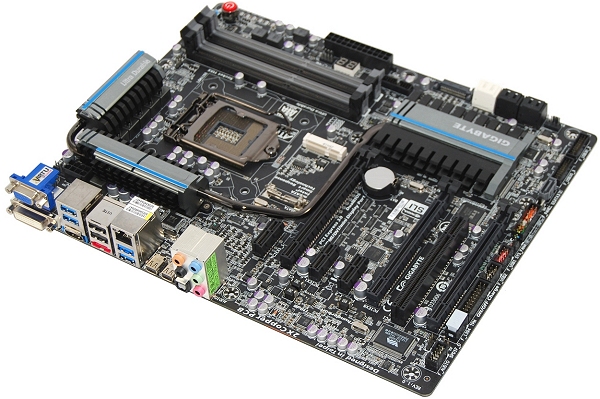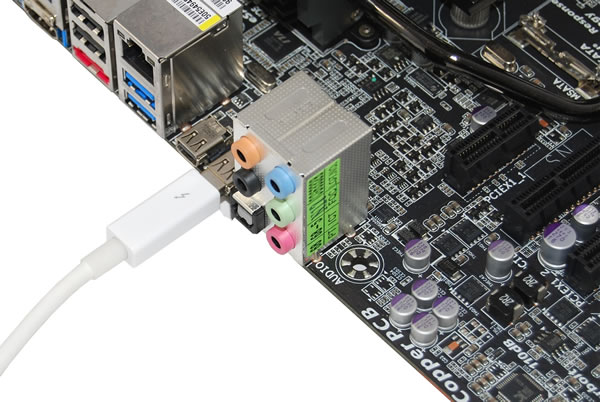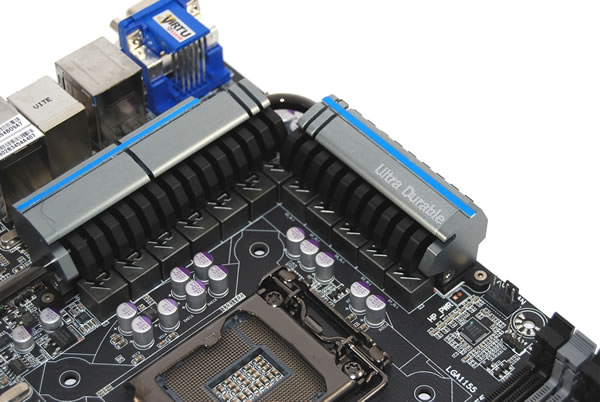Gigabyte Z77X-UP5 TH in Detail
There's no shortage of Intel Z77-based motherboards from Gigabyte, with well over a dozen different models in production today. This lineup is home to several unique products such as the G1.Sniper 3 and Z77X-UP7, as well as the new TH (Thunderbolt) boards: the Z77MX-D3H TH, Z77X-UP4 TH and the Z77X-UP5 TH.
Although it's one of the pricier Z77 motherboards at $250, we think the Z77X-UP5 TH's price is justified considering its rich feature set. The Gigabyte Z77X-UD5H-WB was featured in our Z77 roundup this year and it was our favorite board at $210 thanks to its wealth of features, so we hope to find the same this time.
The Z77X-UP5 TH features a mass of onboard SATA, eSATA, Firewire, and USB 3.0 ports, three PCIe x16 slots, high-quality audio, plenty of display outputs, as well as a PCIe add-in card supporting Bluetooth 4.0 and Wi-Fi. Very few Z77 motherboards we've seen are able to match the Z77X-UP5 TH in terms of raw features.


The Z77X-UP5 TH uses the same PCI Express x16 configuration as the Z77X-UD5H-WB we reviewed, supporting both AMD Quad CrossFireX and Nvidia Quad SLI via two PCIe 3.0 x16 slots, which run at x8/x8 when both are occupied. The third PCIe x16 slot supports the older 2.0 standard and is wired for x4 bandwidth.
The board has four DIMM slots for up to 32GB of RAM running at 1066, 1333 and 1600MHz, while 2133 and 2400MHz are possible via overclocking. Whereas the Z77 provides six SATA ports (two 6Gb/s), Gigabyte includes a Marvell 88SE9172 6Gb/s controller for another two ports: one is onboard and colored gray, one is used for eSATA on the rear I/O panel.
There's also an mSATA connector above the primary PCIe 3.0 x16 slot for SSDs using Intel's Smart Response Technology, though this occupies the Z77's fifth SATA 3Gb/s port when in use.

Network connectivity comes from a single Gigabit network controller, being the Intel WG82759V. A Bluetooth 4.0/Wi-Fi PCIe x1 expansion card, the GC-WB300D, is also included and represents a $30 value. It supports Smart Ready technology and has a Mini PCIe port that is loaded with an Atheros AR5B22 card.
The Realtek ALC898 codec supplies 7.1 channel audio, while this Gigabyte implementation also supports X-Fi Xtreme Fidelity and EAX Advanced HD 5.0 technologies, making it a relatively high-end solution.
The Z77X-UP5 TH carries six USB 2.0 ports (two on the I/O panel, four via headers), as well as eight USB 3.0 ports (four in back, four via headers). Intel used two VIA VL810 Hubs to turn the Z77's four USB 3.0 ports into eight.
FireWire is also on the menu thanks to the VIA VT6308, an old PCI solution that supports two 400Mb/s IEEE1394a ports (one on the I/O panel, one via header). Providing the board with legacy PCI support is the ITE IT8892E chip, a PCIe x1 to PCI 32-bit bridge supporting three PCI slots.



As pleased as we are about the extensive USB 3.0 connectivity and FireWire support, the crown jewel is Thunderbolt. Using the Intel DSL3510L chip, the Z77X-UP5 TH offers two Thunderbolt ports allowing users to daisy chain up to 12 devices plus two displays.
While one of the legacy PCI interfaces is connected to the VIA VT6308S, another provides a traditional PCI slot. Still, the good news is Gigabyte has included three PCIe x1 slots, giving the Z77X-UP5 TH a more modern feel compared to many other Z77 motherboards we've seen.
The Z77X-UP5 TH features Gigabyte's new 3D Power technology, which is an all new hardware and software-based digital power engine for both the PWM and memory that delivers extraordinary power delivery control.


It utilizes a new digital PWM controller with precise auto voltage compensation to deliver a steady flow of power to the CPU and memory no matter the loading. Gigabyte is the first in the industry to utilize digital memory controllers for not only the memory, but VTT and VSA, for real-time monitoring and adjusting.
The digital memory control allows users to monitor and record DDR power and current in real-time while gaming, overclocking or at idle. Users can also set OVP (Over Voltage Protection) to safeguard their memory, adjust memory Load-line Calibration to fix memory vdrooping for a quicker response time and adjust memory PWM frequency on the fly.
